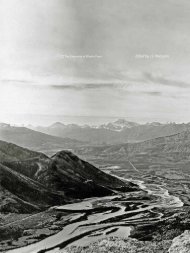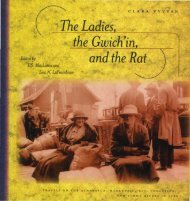Paul Kane's Journal of his Western Travels, 1846-1848 - History and ...
Paul Kane's Journal of his Western Travels, 1846-1848 - History and ...
Paul Kane's Journal of his Western Travels, 1846-1848 - History and ...
You also want an ePaper? Increase the reach of your titles
YUMPU automatically turns print PDFs into web optimized ePapers that Google loves.
The channel is divided by a large i l<strong>and</strong>, hence <strong>Kane's</strong> name<br />
for it when he passed it on June I, <strong>1846</strong>. On SepleI11ber 12,<br />
<strong>1848</strong>, during <strong>his</strong> return nip. he chose to call lhe falls gr<strong>and</strong><br />
Shute <strong>and</strong> the gr<strong>and</strong> rapped.<br />
Isle roy. Isle Royale, now part <strong>of</strong> .a national parte in lhe state <strong>of</strong><br />
Michigan, is lhe largest isl<strong>and</strong> in Lake Superior, st<strong>and</strong>ing<br />
<strong>of</strong>fshore from Thunder Bay <strong>and</strong> the fur trade posts <strong>of</strong> Gr<strong>and</strong><br />
Portage <strong>and</strong> Fort William on the north shore, 165 miles nonheast<br />
<strong>of</strong> Duluth, Minnesota.<br />
Jaculxs, Mr Pahtahsega (Pautaussigae), also known as Peler<br />
Jacobs ( 1807 - ) 890), was a Mississauga Ojibwa, not a "half<br />
brede, .. who converted to Christianity early in <strong>his</strong> life. Shortly<br />
after <strong>his</strong> conversion. he read from the New Testament in<br />
English <strong>and</strong> Ojibwa at a meeting in New York <strong>of</strong> the Missionary<br />
Society <strong>of</strong> lhe Melhodist Episcopal Church. Jacobs worked<br />
at missions near Norway House <strong>and</strong> at Fort Alex<strong>and</strong>er, traveling<br />
to Engl<strong>and</strong> in 1842 to be ordained. Returning to the West,<br />
he was stationed, when Kane saw him, at Fort Frances. He<br />
went to Engl<strong>and</strong> again, in 1850, but without permission. <strong>and</strong><br />
was expelled by the Methodists in 1858 for soliciting funds<br />
without church approval. Pahtahsega was one <strong>of</strong> the most<br />
critical opponents <strong>of</strong> the HBC whom Kane met; the missionary's<br />
chief complaints were the company's immoral practices<br />
<strong>and</strong> way <strong>of</strong> life. Besides seeing him at Fort Frances, Kane,<br />
according to WA (49), rode with him to Upper Fort Gany on<br />
June 13, <strong>1846</strong>.<br />
~pers / jaspers House See gaspers.<br />
jMpers Iake/.i-pers Lake Today's Bride Lake, a widening <strong>of</strong><br />
the Athabasca River at the eastern gate <strong>of</strong> Jasper National Park<br />
in western Alberta. t<strong>his</strong> lake is continually swepl by winds,<br />
which <strong>of</strong>ten reach gale force, coming out <strong>of</strong> the mountains.<br />
The lake is shallow, with many s<strong>and</strong> bars at the upriver end.<br />
jochet, Father In 1843, Father Joseph Joset emigrated from<br />
France to the West, where he spent <strong>his</strong> life as a missionary. He<br />
worked out <strong>of</strong> Coeur d' Alene mission (see Cour de lane) on<br />
the Spokane River.<br />
King <strong>of</strong>tbe frencb Louis Philippe (1773- 1850), Ie Roi ciroyen,<br />
was king <strong>of</strong> France from 1830 until <strong>1848</strong>, when he abdicaled<br />
<strong>and</strong> fled Paris.<br />
Knew Caladonia New Caledonia was the HBC's name for its<br />
fur trade district on the Pacific Slope north <strong>of</strong> the Columbia<br />
district. Roughly speaking. t<strong>his</strong> disuict covered the drainage<br />
basin <strong>of</strong> the Fraser River, in the interior <strong>of</strong> modem British<br />
Columbia.<br />
Lack Ie PIue<br />
See Raney Lake.<br />
lake Atba"-ca Kane does not mean the large lake <strong>of</strong> t<strong>his</strong> name<br />
in northern Alberta, but another widening <strong>of</strong> the Athabasca<br />
River, upriver <strong>of</strong> BrUle Lake but downriver <strong>of</strong> modem Jasper<br />
Lake, where Jasper House was located. T<strong>his</strong> stretch <strong>of</strong> river is<br />
not conunonly regarded today as a lake, <strong>and</strong> bears no name <strong>of</strong> its<br />
own; nor was the name, lake Athabasca~ retained in WA.<br />
Lake de Booet Lac du Bonnet, a widening <strong>of</strong> the lower Wmnipeg<br />
River, still exists, but has been much altered by hydroelectric<br />
developments. It marks the beginning <strong>of</strong> the lower stretch <strong>of</strong> Ibis<br />
river.<br />
The American Art <strong>Journal</strong>! Volume XXI • Number 2<br />
lake de Roch Rock Lake, a widening <strong>of</strong> the Pembina River east<br />
<strong>of</strong> Twtle Mountain, is in modem southwestern anitoba.<br />
Lake <strong>of</strong> they 1000 IsIancb Lac des Mille Lacs i lhe - 1803<br />
fur trade route's first lake in the Lalce Winnipeg (Hudson Bay<br />
watershed that brig headed w t reached afier crossing the<br />
height <strong>of</strong> l<strong>and</strong> from Lake Superior, Kaministilcwia River, <strong>and</strong><br />
Great Dog Lake. Beautifully tudded with i l<strong>and</strong>s, its shores<br />
touch the Trans-Canada Highway at the settJemem.<strong>of</strong> Savanne,<br />
Ontario.<br />
Lake <strong>of</strong> they Woods/Lake <strong>of</strong> the Woods A huge, complex<br />
lake strnddling the modem Ontario/Minnesota border, t<strong>his</strong><br />
lake, having Rainy Lake flowing into <strong>and</strong> Winnipeg River<br />
flowing out <strong>of</strong> it on the fur trade route, caused voyagews<br />
constant navigational complexities. They had 1.0 knife their<br />
way through isl<strong>and</strong>s <strong>and</strong> grau the western tip <strong>of</strong> Aulneau<br />
peninsula.<br />
the lakes/the Lakes T<strong>his</strong> nondescript identification refe t.o<br />
Upper Arrow Lake <strong>and</strong> Lower Arrow Lake, natural widenings<br />
<strong>of</strong> the Columbia River which account for almost eighty miles<br />
<strong>of</strong> the river's length in the southern part <strong>of</strong> modem British<br />
Columbia. Kane passed through them November 17-18,<br />
<strong>1846</strong>, <strong>and</strong> again September 25-29, 1847.<br />
Lake Winapeg Lake Winnipeg, the sixth largest in Canada <strong>and</strong><br />
second longest lraverse on the fur trade routes after Lake<br />
Superi.or, is over 260 miles long, having both Wmnipeg <strong>and</strong><br />
Red rivers feeding it on the south, <strong>and</strong> taking in the waters <strong>of</strong><br />
me Saskatchewan River on the northwest. It dominates pres~<br />
ent~y central Manitoba. Although unpossessed <strong>of</strong> Lake <strong>of</strong><br />
the Woods 's navigational complexities, it caused voyagews<br />
endless anxiety because its extremely shallow waters (onJy ten<br />
or twelve feet for much <strong>of</strong> its swface) produced steep-fronted,<br />
choppy waves, not the long swells <strong>of</strong> mammoth Lake Superior.<br />
Neither the canoe nor the Yoric:: boat (nor even the sloop that<br />
Kane sailed on in July, <strong>1846</strong>) h<strong>and</strong>led with ease the tempests<br />
that so <strong>of</strong>ten blew up suddenly on t<strong>his</strong> great but shaUow lake.<br />
Apart from the crossing <strong>of</strong> the southernmost part <strong>of</strong> the lake,<br />
from the mouth <strong>of</strong> the Winnipeg (0 the moulh <strong>of</strong> the Red River,<br />
on June 11 <strong>and</strong> 12, <strong>1846</strong>, Kane made two entire travm;es <strong>of</strong>me<br />
lake: both involved Norway House, <strong>and</strong> they took him up <strong>and</strong><br />
d.own the east side <strong>of</strong> the lake, with traver.;es at the narrows,<br />
<strong>and</strong> then across the top <strong>of</strong> me lake, from Norway House to the<br />
mouth <strong>of</strong> the Saskatchewan River. Only a ingle isl<strong>and</strong> is<br />
mentioned in the description <strong>of</strong> the trip by sloop in <strong>1846</strong>.<br />
(perhaps Kane was too busy acquiring <strong>his</strong> sea legs (0 make<br />
other observations.)<br />
On the <strong>1848</strong> return trip, Kane' s journal identifies the features<br />
<strong>of</strong> the shoreline as follows: little isl<strong>and</strong> is al the neck<br />
between Lake Winnipeg <strong>and</strong> Playgreen Lake; spder Isl<strong>and</strong>s lie<br />
<strong>of</strong>f the nonheastem shore; point de Tramble (tremble, Fr. for<br />
"poplar' ') or papeler point is the name <strong>of</strong> the point where the<br />
Poplar River flows into the lake on the east shore; Bareings<br />
river is Berens River, which flows into the lake from the east at<br />
about its middle; stwgun river, probably present-day Pigeon<br />
River, is the next principal tributary on the east side as one<br />
travels south, above rabbet point, wJtich begins the arrow ;<br />
dogs hed, or the Narrows, is today's Bullhead, Manitoba on<br />
the west shore, where the lake's girth dwindles to a mere two<br />
<strong>and</strong> a half miles; Lune narrows (Loon Narrows), back on me<br />
east shore, occurs where a narrows separates an isl<strong>and</strong> from a<br />
prominent point twenty miles south <strong>of</strong> the Narrows; buffalo<br />
75
















